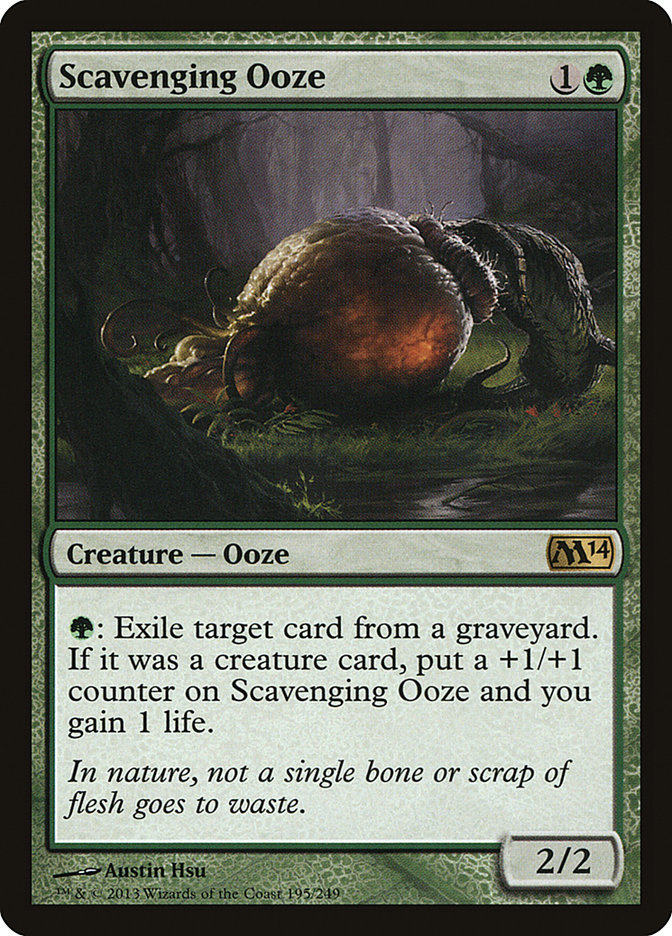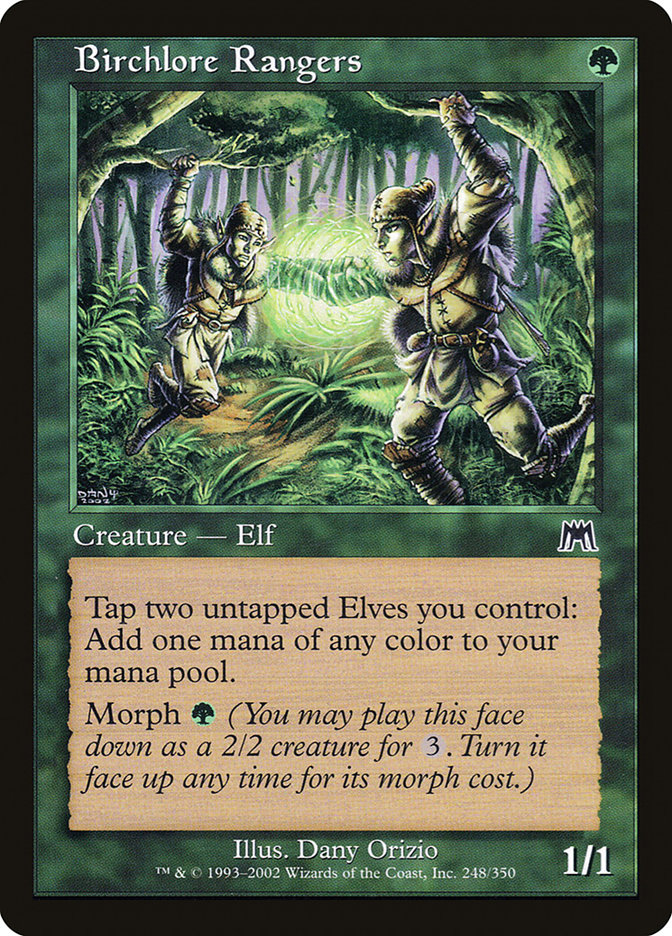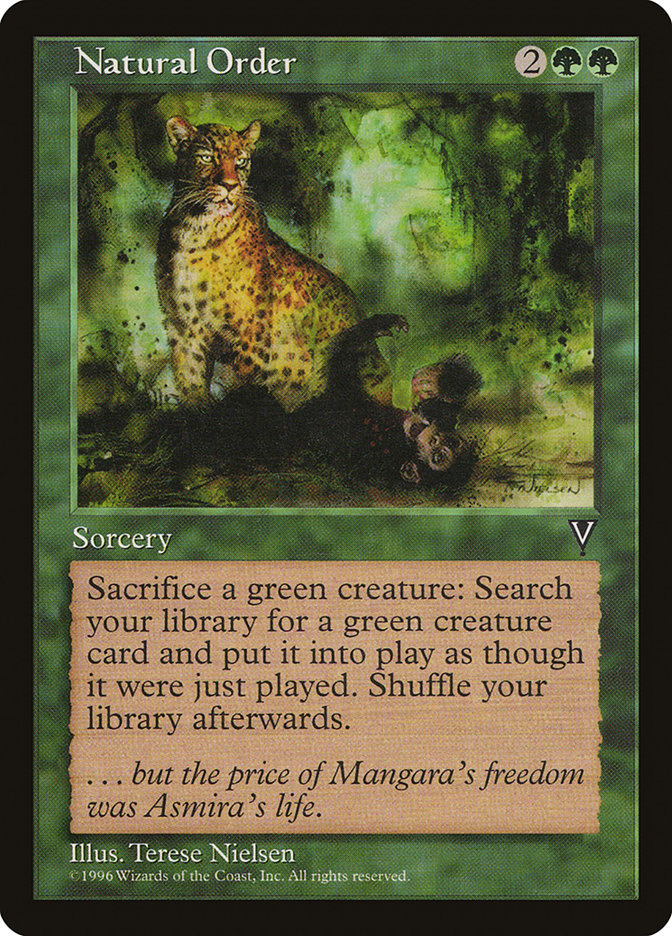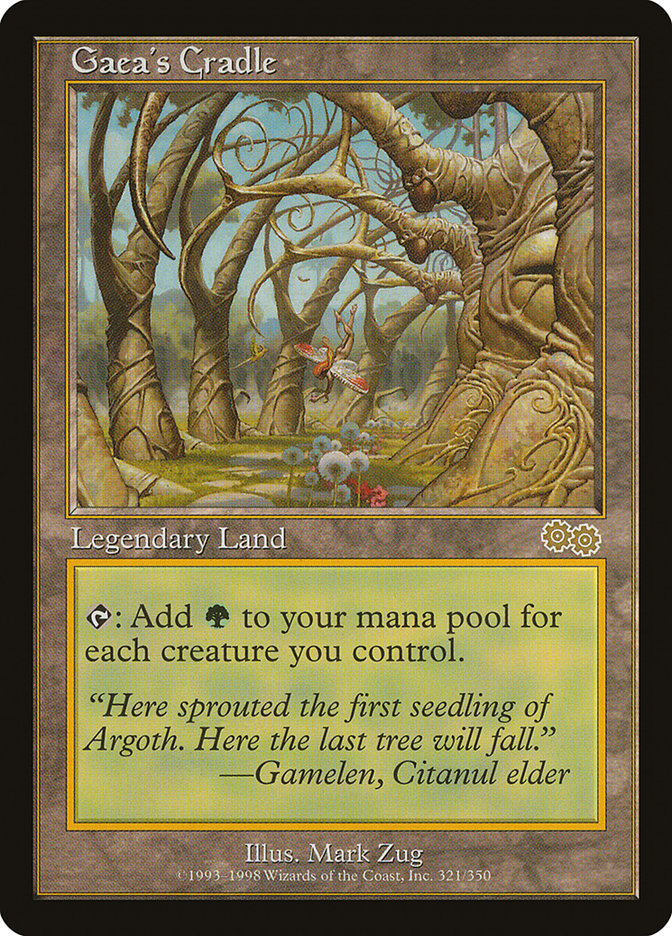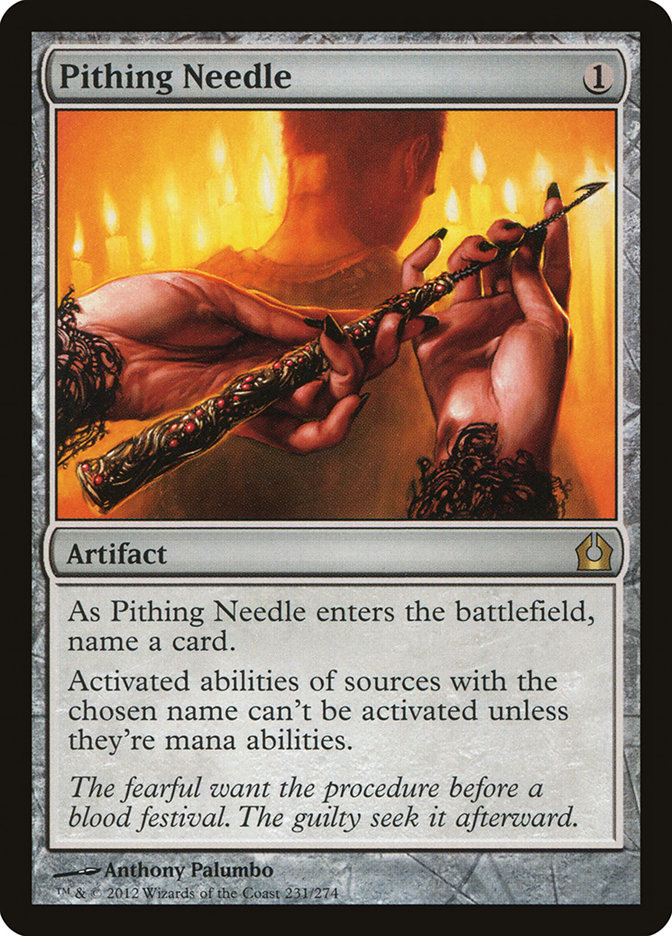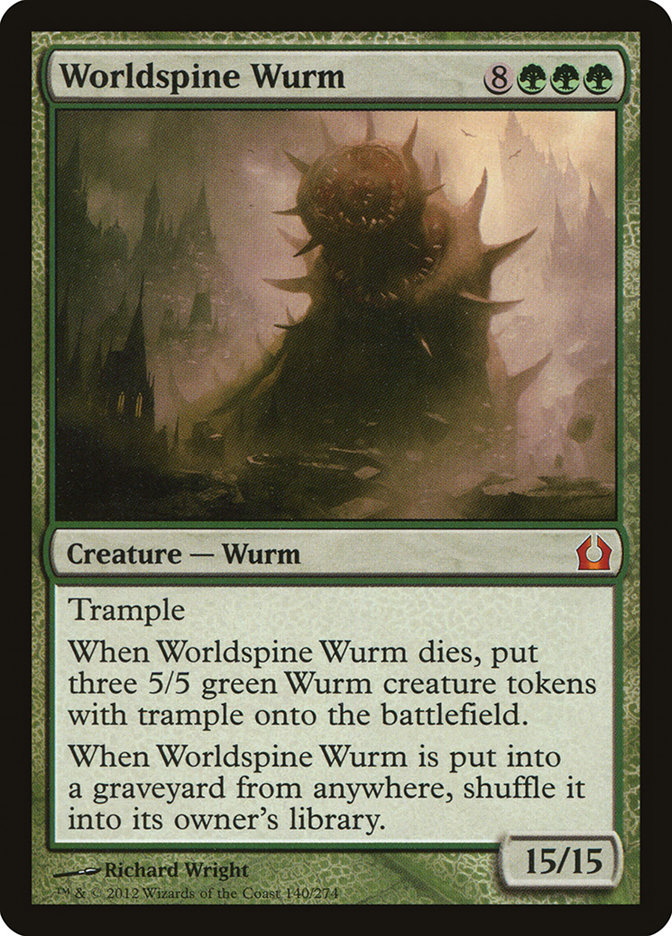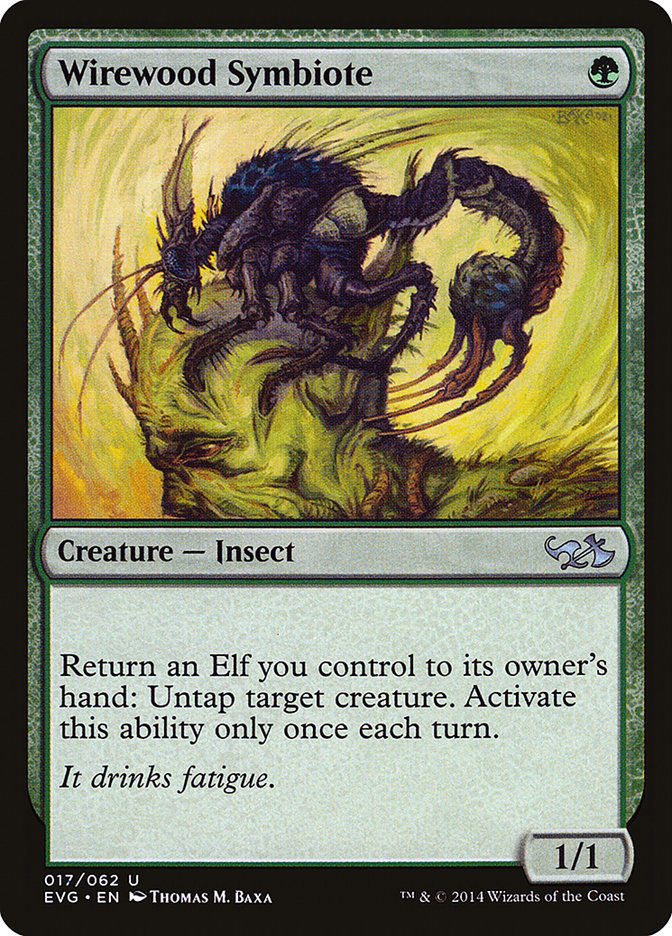So it has come to this…
I feel like I am doing a clip show or a greatest hits record as though I am out of interesting material. In reality, this was always something I intended
to do but delayed it for two reasons:
1) As an anticipated piece, I wanted to ensure it was my best effort.
2) I felt it was important to introduce myself to StarCityGames.com’s readership through more original content.
To elaborate on the second point, I did not want to write about the obvious, expected topic of Elves too early so I could establish myself through
different means. At the risk of sounding conceited, I like to think I was offered this position for more than my tournament results and writing an Elves
primer early in my tenure suggested just that.
Conversely, I relish my status as an expert of a given archetype and looked forward to offering a comprehensive guide to one of my favorite decks,
especially since my opinions deviate significantly from commonly offered advice.
Without further ado, here is everything I know about Elves.
History
The current Elf Combo deck began in the now defunct Extended format at Pro Tour Berlin in 2008. With one of the most dominant performances in Pro Tour
history, there were six copies of the deck
in that top 8. Notably, this was before the split-format so the players used their Constructed decks for the full sixteen rounds.
The key addition was the powerful engine of Nettle Sentinel and Heritage Druid, which when combined with a forgotten bulk rare from Kamigawa Block, Glimpse
of Nature, allowed you to establish a board where each elf cast would both add mana to your mana pool and draw at least one card. Unsurprisingly, given the
density of creatures in the deck, this generally leads to drawing your entire deck, adding 20+ creatures to the battlefield, and incidentally killing your
opponent with whatever win condition you have decided on. As you can see from the lists, Predator Dragon was the most common choice in Berlin, with Mirror
Entity and Grapeshot as other options. With early mana acceleration and the powerful tutors in the deck, Elves could win as early as turn 2 and
consistently on turn 4.
Unlike the present iteration, the Extended version was a pure combo deck that used the Elvish Visionary + Wirewood Symbiote engine to generate the
necessary card advantage to play though sweepers and other disruption. It was rare for the deck to take to the red zone and attack for the win through
typical means, although Luis Scott-Vargas famously did so throughout that top 8, using his sideboard copies of Umezawa’s Jitte to great effect. Most of the
lists used their sideboards exclusively for silver bullets (Orzhov Pontiff, Burrenton Forge-Tender), disruption for other combo decks (Thoughtseize, Thorn
of Amethyst), and added resilience to opposing removal (Fecundity).
Because of the linear nature of the deck, the metagame was successfully able to combat the deck during the ensuring PTQ season, rendering it one player
among many viable decks rather than the default best option.
The powerful Extended engine was quickly ported to Legacy, ultimately finding moderate success on the fringe of the metagame. The most notable champion of
this iteration of the deck was Chris Andersen, and Mirror Entity grew to
be the most common kill condition due to its applications when the deck shifts to a beatdown plan. The deck in general was over-reliant on Glimpse of
Nature and had little recourse when deprived of resources because its secondary card advantage engine, Regal Force, was so expensive.
The version of Elves that has risen to be a top contender had its genesis at Grand Prix Denver in the first week of 2013. Matt Nass, already an established
Elves master, made top 8 with a list that
used Natural Order and Craterhoof Behemoth that created a new avenue to victory, importantly one that was effective with a relatively small board of a few
elves and a few lands. Having worked with Matt earlier that month for the StarCityGames.com Invitational in Los Angeles, I was fortunate to be privy to an
early list of the deck, and I like to think that my fervent support of the deck was helpful in his choice to play it in the event. In reality, I am pretty
sure Matt has never played a non-Elf deck when one was viable.
The key additions to the Elves deck were Natural Order, Craterhoof Behemoth, Deathrite Shaman, and Abrupt Decay. Natural Order for Craterhoof Behemoth is a
robust win condition that allows the deck to win from a very low base of resources, while Behemoth itself is surprisingly easy to cast naturally with
Gaea’s Cradle or a strong Heritage Druid draw. This greatly reduced the deck’s reliance on Glimpse of Nature as a win condition, which in turn, reduced the
effectiveness of common hate cards for the Glimpse combo, like Ethersworn Canonist.
Deathrite Shaman, as I will expand on below, allows the deck to play a large number of one mana accelerants without playing many copies of Llanowar Elves,
if any. Llanowar Elves are terrible midgame draws, while Deathrite Shaman is one of the most powerful creatures in Legacy, especially when you can untap it
for multiple activations in a turn.
Perhaps the most important addition, Abrupt Decay, gave Elves a powerful yet versatile sideboard card against the wide array of problematic permanents in
Legacy, from Delver of Secrets to Counterbalance to Ethersworn Canonist to Grafdigger’s Cage. This allows the Elves player to fill their sideboard with
more impactful cards and not have to worry about being caught unprepared for the multitude of fringe archetypes in Legacy.
It took a while for the current Elves lists to be adopted as the premier version, and even longer for the deck to be accepted as a top tier deck in the
metagame, but it has been one of the most popular and successful decks on the Open Series in 2014, even taking all four semifinal slots at the Legacy Open
in
Indianapolis
in September.
Maindeck Construction
With rare exception, every maindeck list of Elves I have registered since 2012 has fallen into the following model with 20 lands and 40 non-lands:
3- 4 Heritage Druid
3-4 Natural Order
0-2 Llanowar Elves
10 Green fetchlands
2 Bayou
0-1 Splash Dual Land
1-2 Forest
The list I have for Grand Prix New Jersey is the following:
Creatures (28)
- 4 Wirewood Symbiote
- 4 Quirion Ranger
- 2 Birchlore Rangers
- 4 Heritage Druid
- 4 Nettle Sentinel
- 4 Elvish Visionary
- 2 Craterhoof Behemoth
- 4 Deathrite Shaman
Lands (20)
Spells (12)

I would now like to highlight the choices I have made that deviate from established norms.
As you can see, there is little, if any, “spice” to these lists. Elves is a deck that gains its resilience through the versatility of its cards and its
varied angles of approach. As such, I prefer to not interact in game 1, and focus on my own combo. Killing your opponent is the universal answer to hate
cards. It is very common for Elves lists to maindeck a Scavenging Ooze and a Reclamation Sage, typically shaving a copy each of Heritage Druid and Nettle
Sentinel. I have not found the value of these cards as tutor targets to outweigh the downside of drawing them when they are not effective. I have played a
Scavenging Ooze in the maindeck before and will consider it from time to time, but it is not a good solution to Treasure Cruise since it does not come
online fast enough, so my advice for the current metagame is to leave it in the sideboard.
Reclamation Sage is the more controversial omission, especially with powerful cards like Counterbalance and Umezawa’s Jitte that it can destroy, but going
underneath these cards is a cleaner solution than trying to hold a direct answer anyway, and Jitte can be contained by Quirion Ranger or Wirewood Symbiote
bouncing a blocker. There are very few decks that present enough targets for Reclamation Sage that its synergy with Wirewood Symbiote becomes relevant, or
that you would consistently want access to it in the first place. The primary example of such a deck, Death and Taxes, is a great matchup even without the
maindeck Sage.
Elves works off of assembling a critical mass to start the engine, and every card that does not work towards that goal makes every other card in the deck
worse. Thus, there is a very high barrier for narrow cards in the maindeck, even with a tutor as flexible as Green Sun’s Zenith. That barrier is made
higher by the fact that Craterhoof Behemoth and Dryad Arbor already represent poor draw steps that are required for the deck to function smoothly.
Reclamation Sage, while a necessary effect out of the sideboard, does not meet the bar for maindeck inclusion.
Recently, Ruric Thar, the Unbowed and Wren’s Run Packmaster have gained popularity as additional midrange threats for Natural Order and Green Sun’s Zenith.
Once again, these are rarely cards I wish to draw naturally, Ruric Thar especially, and they push the deck further away from the combo plan. I view these
cards as crutches or safety nets that can be leaned upon to win games when something goes wrong but are unnecessary with careful play.
I have grown to prefer Birchlore Rangers over Llanowar Elves mostly because of the potential for Rangers to produce explosive second turns, typically
alongside Nettle Sentinel. Rangers functions similarly to Llanowar Elves when played on the first turn, allowing you to produce a third mana on the second
turn, but lacks the same synergy with Quirion Ranger and Wirewood Symbiote, as the untap only nets half a mana as opposed to a full mana with Llanowar
Elves. However, between Deathrite Shaman and Dryad Arbor with fourteen ways to find it between Green Sun’s Zenith and fetchlands finding a mana producer to
go with the untap effects is easy enough that I weigh benefits of Birchlore Rangers as higher.
I added the fourth Natural Order after the myriad of times where I realized it was the card I most hoped to draw in the midgame and almost never died with
extra copies in my hand, while resolving it essentially ended the game in my favor. Natural Order is the card that elevated Elves to a top contender in
Legacy, because it is a powerful threat when light on resources. Even when reduced to a board of 1-2 creatures, Natural Order threatens to put Progenitus
into play and completely trump the opposition. Some lists of Elves opt for a Wren’s Run Packmaster as a midrange threat in the maindeck that also makes
Green Sun’s Zenith a potential game winner when you cannot cast it for enough to find Craterhoof Behemoth, but I once again prefer not to clutter the deck
with cards that are often poor draws.
Ten fetchlands may seem like too many, but I would not play fewer, and frequently pine for the eleventh. There are many lists that play nine, and I have
seen lists with eight or even seven, and I find that completely inexplicable. The deck needs so few lands to function that having three or more basics in
order to play Wasteland is clearly excessive. Fetchlands serve as extra ways to find Bayou and Dryad Arbor when necessary, as well as to feed Deathrite
Shaman. It is paramount that a turn 1 Deathrite Shaman function as a mana accelerant as the difference between two and three available mana on turn 2 is
incredible. With acceleration, Elves can easily outpace interaction, but without it, the race is difficult.
While it is accepted as stock at this point, I would like to end this section with some brief comments on Gaea’s Cradle. The previous iteration of this
deck, that which was championed by Chris Andersen, often played fewer than four copies of Cradle out of fear of drawing dead copies under the old legend
rule. It also played a few copies of Crop Rotation to chain copies of Cradle for extra mana and gain access to some powerful sideboard options like Karakas
and Bojuka Bog. The new standard of playing all four emerged out of the changing of the legend rule, alleviating the fear of drawing dead copies.
Playing fewer than four copies of Gaea’s Cradle is, and always was, unequivocally wrong.
Gaea’s Cradle is the best card in the deck. By a lot. By more than what you are thinking right now. Much more. I believe that it is the most powerful
individual card in the entire Legacy format. As a land that regularly taps for 3-5 mana, it is often comical to watch opponents flounder in the face of
such a resource advantage which snowballs as Gaea’s Cradle allows you to develop your board to ridiculous sizes.
Don’t cut Gaea’s Cradle. When you see two in your opening hand and no way to make the first mana, just continue to be glad that WOTC lets you play with the
card at all.
The Sideboard
My current Elves sideboard is the following:
4 Cabal Therapy
2 Thoughtseize
3 Abrupt Decay
1 Sylvan Library
1 Pithing Needle
1 Scavenging Ooze
1 Reclamation Sage
1 Progenitus
1 Worldspine Wurm
As a combo deck, the goal of Elves in sideboarding is to address problematic cards from the opponent in the most minimalist way possible. Every elf removed
in sideboarding makes the rest of the deck weaker, and while this effect is often minimal for each elf, it is quite noticeable once you start cutting more
than 4-5 of them, which is why I try very hard to avoid doing so. You should be trying to answer just enough of their cards to open a window for the combo,
not shift completely to a midrange game plan out of fear for the opposing sideboard. The exceptions to this are matchups where your combo plan is
strategically mismatched (mostly Miracles and faster combo decks), and I will address those in the matchup section below.
Since the total number of cards brought in is low, each card has to be incredibly high impact, although this also allows us to reduce overlap between
cards. That is, Elves can afford to sideboard cards for a more specific subset of the metagame than other decks since those decks are trying to make a more
substantial change in their post-board configuration.
Personally, something very drastic would have to change for me to cut anything but the Pithing Needle, Sylvan Library, and Worldspine Wurm. The discard
spells are essential and applicable against every combo deck. I have favored Cabal Therapy over Thoughtseize in the split because I prefer it in the mirror
where I do not want all six discard spells, and it offers more potential to cripple the opposition.
There are lists of Elves that eschew the black splash for a blue one, preferring to play cheap counterspells such as Swan Song, Spell Pierce, and
Flusterstorm to combat other combo decks, but I find the proactive disruption to be much more effective since it allows you to use your mana more
efficiently. Holding up even a single mana starting on turn 2 will stunt your own development far too much.
In addition to discard, various permanent sources of disruption have been tried in Elves sideboards, most notably Thorn of Amethyst and Gaddock Teeg.
Neither of these cards is very good against Show and Tell decks, which have eclipsed Storm decks in popularity since the printing of Griselbrand. Gaddock
Teeg has some applications against Miracles, but is not worth splashing a second color, which was mainly done to access Qasali Pridemage before the
printing of Reclamation Sage.
Progenitus and Scavenging Ooze provide the deck with different angles of attack when necessary, allowing Natural Order and Green Sun’s Zenith to operate
outside the scope of the combo when you are light on resources, instead functioning as a standalone threat. This is an important angle in attrition
battles, when your opponent will often be able to prevent you from assembling a combo win while presenting a threat or two that trumps a board of small
creatures.
The last three slots are much more debatable. Sylvan Library has proved incredibly valuable in attrition matchups (Deathblade, Shardless Sultai, Jund), and
you should assuredly play a copy if you expect those types of decks. However, as Treasure Cruise has largely forced many of those decks out of the metagame
in favor of Delver strategies that pressure your life total much faster, Sylvan Library has become less desirable. Having said that, Miracles is still one
of the most played decks, and Library shines in that matchup.
Pithing Needle does great work against Miracles as well, shutting down Sensei’s Divining Top and occasionally Jace, the Mind Sculptor. Top is by far the
most important card in Miracles and the deck often fails to function properly without access to it. You also greatly hinder their ability to produce a
Terminus at instant speed, making Craterhoof Behemoth much more reliable.
Many Elves lists play several copies of Pithing Needle and supplement them with Null Rod in an effort to consistently find them against Miracles, but I
cannot support that plan when cards of this type have such diminishing returns. Null Rod has some applications against Storm, Painter, and Metalworker
decks, so a 1/1 split is defensible, but going beyond that requires you to cut too far into the engine of the deck to find room to bring in relatively weak
sideboard cards.
I feel it important to note that Pithing Needle is often overrated as a sideboard card because it has the appearance of versatility. In reality, Elves is
not interested in answering opposing cards unless they severely hamper its ability to play. I only recommend bringing this card in when it shuts down a key
element of your opponent’s deck, like Sensei’s Divining Top in Miracles or the Grindstone + Painter’s Servant combo. Using Pithing Needle to “answer”
Liliana of the Veil from Sultai Delver, for example, is worse than having an extra creature in your deck.
The Worldspine Wurm was an addition made by Andrew Cuneo for Grand Prix Washington DC to combat the
rise of Sneak and Show. Drawing a Worldspine Wurm offers protection from Show and Tell since it will trump Emrakul, the Aeons Torn or Griselbrand in most
situations and it can serve as a great Natural Order target when overloading on discard spells leaves you light on creatures. Wurm is also strictly better
than Progenitus as a secondary Natural Order target against decks without bounce or Swords to Plowshares, and it can even be untapped by Wirewood Symbiote
and Quirion Ranger when in a race.
The uses outside of the Sneak and Show matchup are marginal, however, and you should only play Worldspine Wurm if you expect Sneak and Show to be popular.
When deciding what to bring out, remember that Heritage Druid and Birchlore Rangers are the worst elves since they require you to have a well-developed
board to be effective. Nettle Sentinel, since it plays well with these cards, also gets worse, but it has more value as a 2/2 since it survives
mini-sweepers like Electrickery, Zealous Persecution, and Golgari Charm and attacks more effectively.
Also do not be afraid to trim on Glimpse of Nature or Natural Order when sideboarding. Glimpse is often a bad draw in the midgame and a liability against
certain cards like Eithersworn Canonist or Sphere of Resistance. Natural Order is weak against decks with Stifle and Wasteland combined with soft counters
like Daze and Spell Pierce while also being a liability in multiples in any fast game. Grafdigger’s Cage is also a concern as that card also stops Green
Sun’s Zenith.
Sideboarding with Elves is about finding the right balance between creatures, kill spells, and sideboard cards. While the kill cards are flashy and
powerful, leaving all eight in when your opponents are often bringing in more removal will leave you too light on creatures to take advantage of them.
Gameplay
I would like to preface this section and the next with some remarks on how to interpret the information presented in them. These are my opinions and mine
alone. I disagree on many important issues with other prominent Elves pilots, and while it is certainly possible to have success following a different
philosophy, I am very confident in my opinions about the deck. When formulating a gameplan for yourself, it is paramount to be consistent and coherent. Do
not follow a matchup plan or tactic I present without understanding and believing in the theory behind it.
I have come to these conclusions with much experimentation, and you may find past videos of me piloting the deck differently. Assume that what I write here
supersedes any previous data. By all means, please compare and contrast what I have written here with your own knowledge and that presented by other
experienced pilots. Such analysis is critical in being a well-rounded student of the game and gaining a complete perspective. However, I would caution
against taking a mix-and-match approach, trying to amalgamate bits of data from every source you encounter, as you will finish with a list that is
incongruous with your tactics. Without further ado, I present my philosophy of Elves and how to approach the most common matchups.
I approach Elves as, first and foremost, a combo deck. You are trying to ignore and trump your opponent’s gameplan, whether through Glimpse of Nature or
Natural Order. Since the pieces of its mana engine are creatures, the deck often survives the trap of previous combo decks that do nothing when
sufficiently disrupted. The creatures can either draw you more cards to go off again (Elvish Visionary + Wirewood Symbiote), or deal twenty the natural
way. Deathrite Shaman is excellent in the deck because it makes the back-up plan much more robust. With the eight untap creatures, it is common to activate
Deathrite Shaman 2-4 times a turn cycle, which is an incredible clock of 4-8 damage even before factoring in the combat step.
This natural resilience to disruption is part of what makes Elves so effective, but it should always remain a secondary part of the deck. You have seen and
will continue to see in the following sections that this philosophy underlies each decision I make with regards to deck construction, sideboarding, and
in-game decision making.
As opposed to a deck like Sneak and Show where you are trying to assemble a very specific combination of cards, Elves operates as an engine, where each
card is a piece and when combined in a multitude of ways, they create huge resource advantages, namely cards and mana.
As such, early in the game, you should always be looking to develop your mana most efficiently. This means leading with an accelerant (Deathrite Shaman,
Green Sun’s Zenith for Dryad Arbor, Llanowar Elves) when possible, unless the Green Sun’s Zenith is necessary to find a critical card later in the game.
The worst turn 1 play is Wirewood Symbiote because it does nothing to generate extra mana the next turn, and its ability does not help you establish a
board. From there you can develop your board aggressively and then assess the game to figure out the most effective way to win: a big Glimpse turn, Natural
Order, or Green Sun’s Zenith for Craterhoof Behemoth.
Of these three, Glimpse of Nature is what I use least often. I have found it better to use Glimpse of Nature aggressively to draw 2-4 cards and establish
an early board advantage, but the traditional Elves combo card still has its place. When setting up your Glimpse turn, it is paramount to determine which
resource, cards or mana, is most scarce and play to maximize it. Earlier in the game you will tend to be lighter on mana, whereas later on you will want to
hold more elves to maximize your cards drawn, but there is no set rule here and your intuition will grow with experience.
When maximizing mana you will often want to establish a copy of Llanowar Elves or Dryad Arbor to synergize with Wirewood Symbiote and Quirion Ranger. It is
also important to realize that you can get multiple Quirion Ranger activations from the same card by bouncing it with Wirewood Symbiote and recasting it.
If you have a Gaea’s Cradle in play, you will want to use any means necessary to cast elves before tapping it, thereby optimizing its mana production. If
your mana is coming from Heritage Druid or Birchlore Rangers then it is important to play Nettle Sentinel as soon as possible to make best use of its untap
ability.
When maximizing cards drawn, the most important question to answer will be what the minimal number of creatures necessary to establish a mana engine for
the Glimpse chain is. The most common mana engine is Nettle Sentinel + Heritage Druid, with Birchlore Rangers serving as a less powerful but less demanding
Heritage Druid. With Heritage Druid you will want to be able to get to three elves on lands alone, while Birchlore Rangers only requires two. From there
you will want to prioritize Wirewood Symbiote and Elvish Visionary since both will give you two cards when cast with an active Glimpse of Nature.
Natural Order is the win condition I use most often, as I favor its simplicity. It often surprises people how few creatures are needed for a Craterhoof
Behemoth trigger to produce a lethal attack, but rarely is it more than four. Even if you can only attack with three creatures, that is twelve points from
the trigger and at least seven points from their initial power, making the attack for nineteen.
When your board is larger than that, the only factor that keeps a Craterhoof Behemoth from being lethal is number of attackers, so always keep in mind that
you can use Quirion Ranger and Wirewood Symbiote to untap creatures after the trigger and generate more attackers. This trick is even more useful when
winning with the more mana intensive options: Green Sun’s Zenith or a Craterhoof Behemoth cast from hand.
There is some tension between Glimpse of Nature and Natural Order in that the former incentivizes you to hold creatures in your hand, while the latter
encourages developing your board. In an ideal scenario I will have enough creatures on board that a Natural Order is lethal while also holding a few
creatures in my hand for a Glimpse, but otherwise I will favor Natural Order as long as the creatures have some value in combat and I am not too exposed to
a sweeper.
So what do you do when the plan goes awry? When they have Thoughtseized your Glimpse and countered your Natural Order, leaving you with a seemingly useless
pile of elves? The next step is to assemble Wirewood Symbiote and Elvish Visionary as quickly as possible. With them in play you can bounce the Visionary
with the Symbiote on both your turn and your opponent’s, allowing you to cast it twice a turn for two extra cards.
This engine is vitally important in any attrition match-up and gives the deck the capability to recover from almost any situation. An underrated aspect of
the engine is that it naturally generates time to leverage the cards since Visionary can be used as a blocker and then returned to your hand before damage
is dealt. As such, you should prioritize dealing with evasive attackers like Delver of Secrets rather than ground attackers like Tarmogoyf.
The last option is to start attacking. Oddly enough, attacking with this deck is typically done outside of combat using Deathrite Shaman. Optimizing the
use of Deathrite Shaman is tricky business, but important since this plan is the most tenuous, and you need to limit the time your opponent has to draw out
of it.
With a Deathrite Shaman in play, you will want to maximize the amount of black mana you can produce by fetching for both your Bayous, finding a Quirion
Ranger to allow for an effective third Bayou, and possibly getting a Birchlore Rangers. Quirion Ranger and Wirewood Symbiote will serve to untap the
Deathrite Shaman as necessary. It is generally most effective to use as many untap effects as you can on your turn while still being left with both Bayous
in play. On your opponent’s turn, you should use Symbiote aggressively, while Quirion Ranger should only be used if it is bouncing non-Bayou lands or
producing a lethal activation since each Bayou in play is generally worth an activation on your turn.
As an example, consider my quarterfinal match at the Legacy Open this year in Providence against
Feline Longmore. In the third game, I was able to resolve a Gaddock Teeg to lock Feline out of her own combo and needed to close the game with attackers
and Deathrite Shaman. Pausing at the 32:34 mark of the video, it is my first main phase, and I have just played a second Bayou as my first action for the
turn. The only relevant card in my hand is a second copy of Quirion Ranger. From this position it is possible to win on Feline’s upkeep or in response to a
bounce spell on Gaddock Teeg if she draws one on her turn. Take a minute to see if you can figure out the proper sequence before continuing.
1) Attack with Gaddock Teeg, Quirion Ranger, and Wirewood Symbiote. She takes four damage to eight life.
2) Cast Quirion Ranger with Dryad Arbor
3) Activate Deathrite Shaman with a Bayou. She goes to six life.
4) Return Dryad Arbor with a Quirion Ranger to untap Deathrite Shaman.
5) Activate Deathrite Shaman with the other Bayou. She goes to four life.
6) Return a Bayou with the other Quirion Ranger to untap Deathrite Shaman.
7) Tap Deathrite Shaman removing a land to make a black mana.
8) Return a Quirion Ranger with Wirewood Symbiote to untap Deathrite Shaman.
9) Activate Deathrite Shaman with the black mana floating. Shes goes to two life.
10) Pass the turn and on her upkeep return the remaining Bayou to untap Deathrite Shaman.
11) Activate Deathrite Shaman to make a black mana.
12) Return Quirion Ranger with Wirewood Symbiote to untap Deathrite Shaman.
13) Activate Deathrite Shaman using the black mana. She goes to zero life.
Note that if there was one less instant or sorcery in the graveyard you can bypass the first Deathrite Shaman activation by attacking with it and the Dryad
Arbor, then using the Bayou, cast the second Quirion Ranger.
I missed this line at the time and was fortunately not punished since Feline’s outs were so slim. It was going through that game that motivated me to
develop the hard heuristics I presented above. I hope what it demonstrated to you is that the mechanics of the Elves deck can be quite intricate. While
daunting at first, this can become quite an advantage over time as your opponents are rarely fully aware of what you are capable of at any given time.
How to Keep Track of Everything
With so many activated and triggered abilities to keep track of and the versatility of plans present in the deck, many newer Elves players quickly become
overwhelmed. Trying to optimize how you use a board of 4-6 creatures or more is no easy task, and one that I often fail in even after over a year of
experience. Here are some useful tricks for organizing your board in such a way that remembering everything becomes easier:
On a combo turn, it is important that you and your opponent know which elves are summoning sick and which are not. Before even attempting the combo,
confirm with your opponent which creatures are, and keep them separate from ones you play that turn. The one exception I tend to make in doing so is Nettle
Sentinel, since it is so convenient to untap them together. In that case I will still confirm how many Nettle Sentinels can attack, that way there is no
confusion when Craterhoof Behemoth comes down.
When using Wirewood Symbiote and Quirion Ranger, remember that they can only be activated once per turn. As such, I will flip them upside-down when I use
them to denote that they cannot be used again.
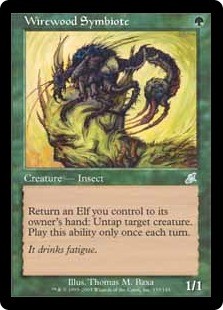
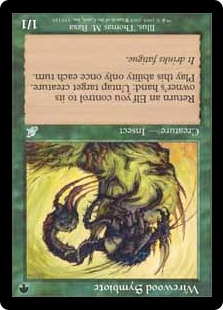
As for more general tips, I find it helpful to take a quick pass over my board at the end of each turn (both mine and my opponent’s) to see if I have
missed something. You cannot dawdle for too long, but a few seconds here and there could make a huge difference.
Also, maximizing your sequencing on Glimpse turns, your use of Deathrite Shaman, or other such mechanics of the deck, can be practiced without an opponent.
If you feel you need more polish in these areas, goldfishing is perfectly reasonable practice. Set down a board of a few elves and a land and see how much
mana you can generate. If you encounter a tricky Glimpse turn in testing, write it down and go back to it later when you have the time to thoroughly
examine every line. Once you hone your solitaire skills, your testing will be much improved, as you will be able to focus more on how to react to what your
opponent is doing and less on how to properly manage the operations of the deck.
Matchups
VS Stifle/Wasteland Delver (Temur, Sultai, Jeskai)
These decks are falling out of favor with the rise of Treasure Cruise, but this matchup is very instructive so I will begin with it. They are a tempo deck,
so the most important dynamic of the matchup is staying ahead of them on board. If they are forced to use their removal spells before establishing a clock,
those cards become much less effective, as you can often recover on the very next turn. Reducing the pressure on your life total also affords you the
luxury of playing around soft counters like Daze and Spell Pierce, whereas if they are attacking you have to play into them and hope to not get punished.
Do not keep slow hands and keep your life total high. If you gain the early initiative, then they will either fold to your payoff cards or use all their
resources to stay alive, at which point they are playing an attrition game they are ill-equipped to win. Deathrite Shaman is important early to generate
more mana and important late to either close out the game or get you out of range of burn spells.
When sideboarding, Natural Order is a liability since they attack your mana so aggressively and have soft counters for it. I will typically go to two
copies of Natural Order and a single Craterhoof Behemoth. Fortunately, Scavenging Ooze often wins the game by itself, especially against the Temur
versions, so you can trim on Natural Order without losing threat density. The lone exception is against Jeskai Delver, where Swords to Plowshares offers an
efficient answer to Ooze, while they have no graveyard abilities to disrupt. Against Jeskai you instead want to bring in the Reclamation Sage as an answer
to Umezawa’s Jitte.
Abrupt Decay is your most important sideboard card, as Delver of Secrets is their most important card. Stalling the ground is easy, so Delver is their lone
way of establishing a clock unless they are able to keep your board small. It can also answer possible hate cards from their sideboard. Bring in every copy
you have.
Cards to be wary of from their sideboard include: Forked Bolt, Rough//Tumble (Temur only), Submerge, Grafdigger’s Cage, and Grim Lavamancer.
VS Treasure Cruise Delver
The current bogeyman of Legacy, this deck comes in several varieties but the most common is U/R. Many have cited this matchup as being quite poor for
Elves, but I have found it to be favorable with a shift in mentality. The principle of getting ahead early still applies, but with Cruise Delver having
more maindeck removal and fewer ways to attack your lands (not all lists have Wasteland and almost none have Stifle), your Natural Orders are much better.
You will often have few elves in play because of their removal, so I bring in Progenitus (or Worldspine if I have it) and play them more like a midrange
deck than a traditional Delver deck. Note that every time I bring in a secondary Natural Order target, I will cut a Craterhoof Behemoth.
Abrupt Decay is still very important, although Young Pyromancer is much better than Tarmogoyf or even Stoneforge Mystic at establishing pressure, since the
elemental tokens are almost always relevant bodies. Treasure Cruise also lets them play an attrition game more effectively, so you have to be more threat
dense than before. Trimming more elves is fine since their removal makes Heritage Druid much worse, so I cut 2-3 copies along with a copy of Birchlore
Rangers. It is even more important against U/R to keep your life total high, since they play 6-7 burn spells and see a lot of cards between cantrips and
Cruise. Scavenging Ooze, while worse as a threat due to the existence of Young Pyromancer, is more important as a means to get out of burn range.
In addition to the cards listed in the Stifle/Wasteland Delver section, many U/R lists have adopted Electrickery.
VS Miracles
This matchup is the most grueling in the format. Terminus and Counterbalance are both excellent against Elves, and unfortunately, they force you into
opposite directions. Terminus encourages you to keep your board small to mitigate risk, whereas Counterbalance punishes you for leaving cards in your hand.
In game 1, your best option is to be as fast as possible and kill them before they can establish their defenses.
If they do not draw Sensei’s Divining Top, it is possible to win through Elvish Visionary + Wirewood Symbiote, but the virtual card advantage of
Counterbalance can still be difficult to overcome. Fortunately, Natural Order is at a difficult spot in the curve for Counterbalance, and they do not
disrupt your lands, so casting a Craterhoof Behemoth naturally is a very real possibility.
After sideboarding, the games become much different as you slow down significantly and have important tools to break the vice of Counterbalance and
Terminus.
You will definitely want the Abrupt Decays and Reclamation Sage to deal with Counterbalance, as well as Pithing Needle and Sylvan Library. I also like to
bring in the two Thoughtseizes because the information is so valuable, and the easiest way to win is to clear a small window for a Natural Order or Glimpse
and capitalize. Still, the games go long enough that drawing Thoughtseize in multiple copies becomes a liability, so I do not like to bring in too many.
Once you have an answer to Counterbalance, you can afford to play conservatively so as to not be crippled by Terminus. The untap creatures are important
because they allow you to grow your board without risking as much to a sweeper. Quirion Ranger in particular is important for protecting Dryad Arbor from
Swords to Plowshares, allowing your fetchlands to turn into creatures after a Terminus. You will want to save your fetchlands as often as possible for this
reason.
While looking for a window in which to strike, you will want to assemble a reasonable clock of 3-5 damage a turn, which Miracles will typically fold to
without a Top. You win more games by damage in this matchup than any other, making Deathrite another very important card. When attacking, be wary of the
flash creatures in the deck: Vendilion Clique, Snapcaster Mage, and Venser, Shaper Savant.
Again, Heritage Druid and Birchlore Rangers are the first elves gone, and I will often go down to one Heritage and zero Birchlore because you bring in
enough cards that early Glimpse turns are less likely, and you rarely extend your board to the point where they are effective. Following this line of
thought, I cut 2 Glimpses as well. The games are so long that I also like to cut a land, especially when on the draw. Given how small your board is, I
believe the correct land to cut is, surprisingly, a Gaea’s Cradle.
I do not like bringing in Progenitus as many other players advocate since they have so many sweepers. After a few attacks, a Craterhoof Behemoth with two
other creatures is enough to kill them so I do not see the appeal of using a Natural Order to establish a two-turn clock over going for the win. This
matchup is about biding your time and either forcing them to blink first and cast their sweepers at inopportune times, or seeing a window to strike and
taking it.
Cards to be wary of from the Miracles sideboard: Supreme Verdict, Grafdigger’s Cage, Pyroclasm, Izzet Staticaster.
VS Mirror
Game 1 in the mirror is a straight race. If you are fortunate to know the matchup going in, then mulligan aggressively, especially while on the draw. A
turn 3 kill on the play will almost always be good enough to win.
The games slow down after sideboarding when each player brings in discard spells. I prefer to only bring in Cabal Therapy since I value taking every copy
of Glimpse of Nature or Natural Order over the consistent value of Thoughtseize. Cabal Therapy should almost always name one of those two cards unless you
are aware of their hand.
I do not want to overload on discard because speed is still paramount. While Elvish Visionary is the worst card pre-board, it gets better once both players
have disruption, and the more your opponent brings in, the better it gets. I like to trim one, possibly two depending on what my opponent is doing.
The second Dryad Arbor is a potential cut, as well as the Birchlore Rangers and Heritage Druid. Even though the latter are explosive, they are poor in
multiples and neither player has removal since Abrupt Decay is poor. The games are still usually over quickly, but if you can, you should leave yourself
the option of establishing Symbiote/Visionary if both players trade a lot of resources early.
VS Other Combo (Storm, Sneak and Show, Reanimator etc)
Despite the perception that Miracles is the nightmare matchup for Elves, it is these decks I fear the most. Game 1 is always tough because they are almost
always faster than you, with the notable exception of High Tide. As in the mirror, you will want to mulligan aggressively and try to race.
Because you are disadvantaged in the race, you need to go further when sideboarding and bring in all the discard spells, along with Pithing Needle,
Reclamation Sage, and Scavenging Ooze when appropriate.
Post-board you play out like a classic aggro-disruption deck, where you tear their hand apart as best you can and then establish the best clock possible.
Since this plan encourages you to extend to the board as much as possible, Glimpse of Nature is once again worse than Natural Order. I trim 1-2 along with
the same elves as in the mirror.
When playing with Cabal Therapy I will try to get a sense as to how fast my opponent’s hand is. If I think it is fast, I will name a key part to the combo,
such as Infernal Tutor or Show and Tell. If I think it is slow, I will almost always name Brainstorm since it is the best card filtering spell they have
and potentially blanks the Flashback on Therapy by allowing them to hide important cards.
Do not underestimate the value of establishing a clock in post-board games. It is tempting to play a discard spell on turn 1 in order to not lose to a
great draw from your opponent, but it is almost always better to play an elf and more quickly establish your board so you shorten the window for your
opponent to recover from Cabal Therapy and Thoughtseize. You want to play your discard spell the turn before your opponent typically goes off.
Most combo decks do not have great sideboard options against you. Leyline of Sanctity is something to watch out for, and you can bring in Reclamation Sage
to deal with it. Many Show and Tell decks also sideboard Pyroclasm, which is fairly easily played around, especially because your discard spells either
strip if from their hand or let you see it coming.
VS Death and Taxes
This matchup is often thought of as a near bye for Elves, but is actually much closer. The Death and Taxes player has plenty of good tools to stunt your
mana in Phyrexian Revoker, Wasteland, and Rishadan Port, some removal in Swords to Plowshares, a fast clock of fliers, and a trump card with Umezawa’s
Jitte.
That said, Death and Taxes has a difficult time deploying all of its disruptive elements in a timely fashion, so your primary goal is to end the game
before they can enact their gameplan. An opening of Mother of Runes into Stoneforge Mystic or Thalia, Guardian of Thraben is easily overrun by a good draw,
but if you stumble they can quickly take advantage and contain your board until their fliers end the game.
Their goal is to trigger Umezawa’s Jitte as quickly as possible so you will want all the Abrupt Decays and Reclamation Sage. Progenitus is also excellent
in this matchup, allowing you to use Natural Order even if you have not established a large enough board to win with a Craterhoof Behemoth.
I like to trim a Deathrite Shaman in this matchup since they have so few cards that feed it, and your beatdown plan is ineffective against a deck that
plays so much on the board. Glimpse of Nature is often vulnerable to their hate bears, notably Spirit of the Labyrinth and Ethersworn Canonist, and their
mana disruption can make it difficult to set up a Glimpse turn. I trim 1-2 depending on how many hate cards I see. Nettle Sentinel’s body is so rarely
relevant that this is the one matchup where it is worse than Heritage Druid. I most often trim one of each just because Nettle is better in multiples and
can enable great starts with Birchlore Rangers.
Containment Priest gives them a powerful new tool in the matchup, and its presence certainly makes Glimpse of Nature better relative to Natural Order,
especially if they play them over Ethersworn Canonist. If they overload on Priests, I would switch back to a Glimpse plan A and trim on Natural Order. It
is easier to deal with the hate bears for Glimpse (Canonist, Spirit) because they are vulnerable to Reclamation Sage.
Sideboard cards to be wary of: Sunlance, Cataclysm, Ethersworn Canonist, Containment Priest, Grafdigger’s Cage, Ratchet Bomb.
VS Attrition Midrange Decks (Shardless Sultai, Jund, Stoneblade Variants)
These decks are good matchups for Elves and have unfortunately been pushed out by Cruise Delver or have adopted Treasure Cruise themselves, which makes the
matchup tougher. Generally, these decks run into trouble after dealing with the first attack by Elves. They have enough disruption to stop it unless their
draw is slow, but they lack the clock necessary to close the door before the Elves deck draws back into the game or simply finds a Natural Order off the
top to win on the spot.
Like Death and Taxes, these decks are often slow to start, especially Shardless Sultai since its spot removal spell costs two mana. A good draw in game 1
will often run away with the game. If they are able to withstand the initial attack, you should prioritize finding the Visionary + Symbiote combo, which
will take over the game if not answered very quickly. As such, I try to save Green Sun’s Zeniths unless my hand is particularly fast and absolutely needs
the turn 1 Dryad Arbor.
These decks will overload on removal after sideboard, hoping to gain an edge with sweepers like Golgari Charm, Zealous Persecution, and Toxic Deluge. This
means you need the secondary Natural Order target. You will also want Sylvan Library since these decks do not present a good clock. Scavenging Ooze is a
solid option against Jund lists with Punishing Fire. Reclamation Sage is needed against Umezawa’s Jitte and is reasonable against Shardless Sultai since it
can hit Grafdigger’s Cage and the value creatures they use to clog the board, Shardless Agent and Baleful Strix.
I try to avoid bringing in reactive cards like Abrupt Decay although a single copy often comes in against Umezawa’s Jitte. If your opponent has Engineered
Plague, you can value Abrupt Decay more highly, but I would not preemptively board Decay for that purpose since Plague is not that common nor is it that
good.
Thoughtseize is better against Esper lists than Sultai or Jund because it can take Jitte after they search for it with Stoneforge Mystic and clear the path
for Progenitus by taking Supreme Verdict. Against Sultai or Jund I prefer to keep my threat density high since Worldspine Wurm is naturally resistant to
Toxic Deluge.
You want to keep your threat density high so trimming more than one Glimpse is not advisable, and I often keep in all four. This is yet another reason to
not bring in too many reactive cards, since you have so few cards you want to cut. The post-board games are very similar to pre-board, although you have to
be more careful against sweepers. Elvish Visionary is still the best card in your deck, and you should assemble Symbiote + Visionary as often as possible.
Sideboard cards to be wary of: Grafdigger’s Cage, Golgari Charm, Zealous Persecution, Toxic Deluge, Disfigure, Engineered Plague.
This should cover the majority of matches you will play in Legacy, but there are too many fringe decks to enumerate here. Feel free to ask me about any
fringe deck you are struggling with.
I am very excited for Grand Prix New Jersey this weekend, and I wish everyone battling with Elves the best of luck. Don’t hesitate to find me and say
hello!


